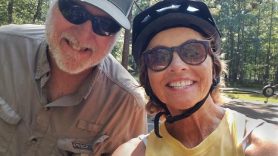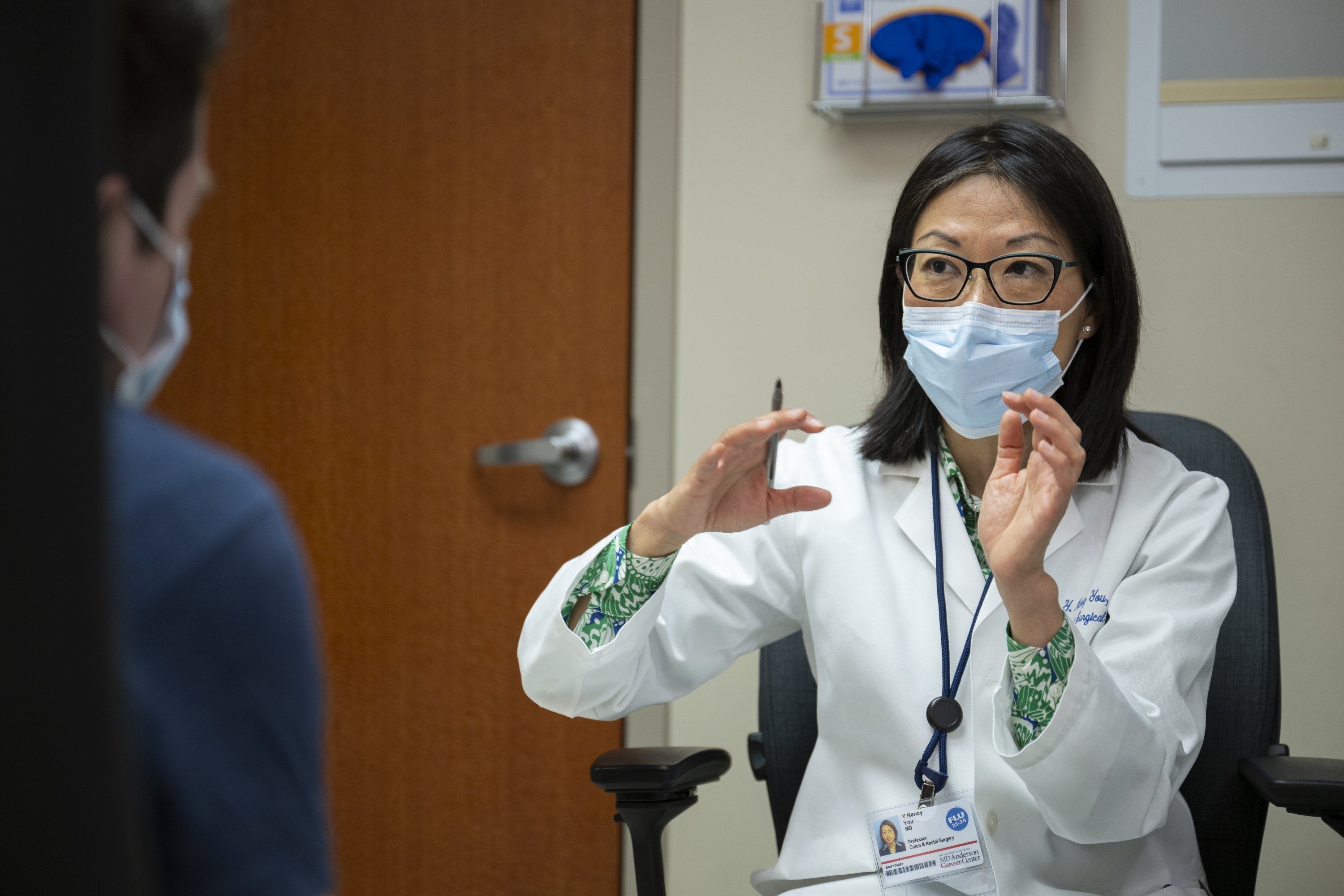- Diseases
- Acoustic Neuroma (14)
- Adrenal Gland Tumor (24)
- Anal Cancer (68)
- Anemia (2)
- Appendix Cancer (16)
- Bile Duct Cancer (26)
- Bladder Cancer (72)
- Brain Metastases (28)
- Brain Tumor (232)
- Breast Cancer (714)
- Breast Implant-Associated Anaplastic Large Cell Lymphoma (2)
- Cancer of Unknown Primary (4)
- Carcinoid Tumor (8)
- Cervical Cancer (158)
- Colon Cancer (166)
- Colorectal Cancer (118)
- Endocrine Tumor (4)
- Esophageal Cancer (44)
- Eye Cancer (36)
- Fallopian Tube Cancer (8)
- Germ Cell Tumor (4)
- Gestational Trophoblastic Disease (2)
- Head and Neck Cancer (12)
- Kidney Cancer (128)
- Leukemia (342)
- Liver Cancer (50)
- Lung Cancer (286)
- Lymphoma (278)
- Mesothelioma (14)
- Metastasis (30)
- Multiple Myeloma (100)
- Myelodysplastic Syndrome (60)
- Myeloproliferative Neoplasm (6)
- Neuroendocrine Tumors (16)
- Oral Cancer (100)
- Ovarian Cancer (172)
- Pancreatic Cancer (160)
- Parathyroid Disease (2)
- Penile Cancer (14)
- Pituitary Tumor (6)
- Prostate Cancer (146)
- Rectal Cancer (58)
- Renal Medullary Carcinoma (6)
- Salivary Gland Cancer (14)
- Sarcoma (238)
- Skin Cancer (296)
- Skull Base Tumors (56)
- Spinal Tumor (12)
- Stomach Cancer (64)
- Testicular Cancer (28)
- Throat Cancer (92)
- Thymoma (6)
- Thyroid Cancer (98)
- Tonsil Cancer (30)
- Uterine Cancer (80)
- Vaginal Cancer (16)
- Vulvar Cancer (20)
- Cancer Topic
- Adolescent and Young Adult Cancer Issues (20)
- Advance Care Planning (10)
- Biostatistics (2)
- Blood Donation (18)
- Bone Health (8)
- COVID-19 (362)
- Cancer Recurrence (120)
- Childhood Cancer Issues (120)
- Clinical Trials (632)
- Complementary Integrative Medicine (22)
- Cytogenetics (2)
- DNA Methylation (4)
- Diagnosis (232)
- Epigenetics (6)
- Fertility (62)
- Follow-up Guidelines (2)
- Health Disparities (14)
- Hereditary Cancer Syndromes (126)
- Immunology (18)
- Li-Fraumeni Syndrome (8)
- Mental Health (116)
- Molecular Diagnostics (8)
- Pain Management (62)
- Palliative Care (8)
- Pathology (10)
- Physical Therapy (18)
- Pregnancy (18)
- Prevention (918)
- Research (392)
- Second Opinion (74)
- Sexuality (16)
- Side Effects (604)
- Sleep Disorders (10)
- Stem Cell Transplantation Cellular Therapy (216)
- Support (402)
- Survivorship (322)
- Symptoms (182)
- Treatment (1786)
CAR T cell therapy put me into complete remission after a non-Hodgkin lymphoma diagnosis
BY Kathy McKay
7 minute read | Published September 26, 2022
Medically Reviewed | Last reviewed by an MD Anderson Cancer Center medical professional on September 26, 2022
I’m a nurse, so when I started experiencing pain and swelling in my lower abdomen, I suspected inflammatory bowel disease, or even worse, colon cancer.
But I soon learned my symptoms were caused by non-Hodgkin lymphoma, a type of blood cancer that develops in the white blood cells. Lymphoma causes these cells, called lymphocytes, to grow out of control and crowd out the red blood cells that carry oxygen throughout the body, and the platelets that control bleeding by helping blood to clot.
I’d never equated a blood cancer with digestive problems. But I learned that it can happen when lymphocytes build up and cause tumors in the lymph nodes located near the gastrointestinal tract. That’s what happened to me, and how doctors were able to spot my disease.
My non-Hodgkin lymphoma diagnosis
My story began about three years ago when I began having stomach problems and fatigue. I’d always been healthy and active, but now I was too tired to even walk around the block. I blamed my fatigue on getting older and switched to yoga. Even that became a struggle.
My family doctor ordered a colonoscopy. The results were normal. But my symptoms kept getting worse. I visited my doctor again. This time, he ordered a CT scan of my abdomen. The image showed numerous, enlarged lymph nodes scattered throughout my lower abdomen. The biggest one was the size of a lime. It was pressing against my abdominal aorta, the largest artery in the body.
A needle biopsy of that lime-sized node showed I had non-Hodgkin lymphoma. “You’ve got to be kidding me,” I told my doctor. Lymphoma wasn’t on my radar. I never would have guessed it.
Chemotherapy, then a double-hit lymphoma diagnosis
My husband and I live in a tiny town in Mississippi, with a single four-way stop sign and no cancer specialists. My family doctor referred me to a cancer clinic in the larger town of Meridian, just a few miles from home. The oncologist there started me on a chemotherapy regimen called R-CHOP, which includes the drugs rituximab, cyclophosphamide, hydroxydaunorubicin, oncovin and prednisone.
It didn’t work. By the time I finished R-CHOP, the cancer had spread. A more extensive biopsy showed I had double-hit lymphoma, a rare and aggressive subtype of lymphoma.
Most lymphomas begin when a white blood cell develops a genetic mutation that tells the cell to multiply rapidly. People with double-hit lymphoma develop not only one genetic mutation but two. You might say that we’re in “double trouble.”
My oncologist said I needed to go to a major medical center to get the highest level of care possible for this challenging diagnosis. We discussed a few options, but he said MD Anderson in Houston was rated No. 1 in the nation. That clinched it for me. That’s where I was going.
Choosing a CAR T cell therapy clinical trial
As soon as we arrived at MD Anderson, I met Dr. Sairah Ahmed, my new oncologist. I knew that I was in the best of hands. Dr. Ahmed had already thoroughly reviewed my medical records from Mississippi. She had a proposal for me: A clinical trial was underway at MD Anderson and other hospitals throughout the nation. She thought I could benefit from joining.
The clinical trial was comparing two different ways of treating lymphoma: the standard treatment of chemotherapy combined with a stem cell transplant, or a newer treatment called CAR T cell therapy. With CAR T cell therapy, infection-fighting T cells are extracted from a cancer patient’s blood. The cells are sent to a lab where they’re genetically engineered to recognize and target a specific protein on the patient’s cancer cells. Scientists multiply these altered T cells in the lab, then reinfuse them back into the patient’s bloodstream to find and attack cancer.
The clinical trial was for people with aggressive non-Hodgkin lymphoma who had not had success with chemotherapy. That described me perfectly.
Dr. Ahmed asked if I wanted to participate. I asked, “If I were your mother, what would you recommend?” She answered, “I’d want you in this trial.”
I signed up.
Preparing for a CAR T cell therapy clinical trial
While Dr. Ahmed worked on getting me into the clinical trial, my husband and I returned home to Mississippi. We loaded our camper with items we’d need for the next couple of months, then drove back to Houston. A campground only a few miles from MD Anderson would be our new home for a while. The campground caters to out-of-town patients who are in Houston for treatment. We formed some strong friendships while living there.
Before starting the trial, I underwent testing at MD Anderson to make sure my body was strong enough for CAR T cell therapy. I had a spinal tap, a lung function test and an echocardiogram to make sure my heart was healthy. And I had lots of bloodwork and lab tests.
Everything checked out OK, and I was admitted to the trial. I was thrilled to learn that I was the very first patient assigned to the CAR T cell treatment group. That meant I could skip a stem cell transplant and test this promising new treatment. And I could help others by moving science forward. As a health care professional, that meant a lot to me.
Getting my T cells – and body – ready for CAR T cell therapy
My lymphoma was aggressive, so we moved quickly.
Within days of joining the clinical trial, I sat in a comfortable reclining chair while a nurse hooked me up to an apheresis machine. It withdrew blood from my veins, collected the T cells, then returned the remaining blood into my body. The entire process was painless and took about four hours. MD Anderson then shipped my T cells to a lab, where they would be genetically engineered to recognize and eliminate my cancer.
It takes about a month to get re-engineered T cells back from the lab. During this time, I underwent a chemotherapy regimen named RICE to keep my cancer at bay. RICE is an acronym for the drugs rituximab, ifosfamide, carboplatin and etoposide. My hair had just started to grow back after the R-CHOP I received in Mississippi. RICE made me bald again.
My CAR T cell infusion and recovery
A month later, my amped-up CAR T cells arrived at MD Anderson. My husband recorded a video of the nurse infusing the cells back into my body. It was a joyous occasion. The room was filled with health care professionals who were watching and cheering me on. I was excited and happy to be moving in the right direction. This time, I was confident I was getting a treatment that would work.
Three days later, I developed a fever. That’s a common side effect of CAR T cell therapy. I was readmitted to the hospital for 10 days so nurses could keep an eye on me until my fever went down. Dr. Loretta Nastoupil, the clinical trial’s leader, stopped by regularly. I felt like a VIP patient. But every patient at MD Anderson is treated like a VIP.
My temperature returned to normal, and I returned “home” to the campground. I spent the next month riding the campground’s shuttle back and forth to MD Anderson for checkups. CAR T cell patients are required to stay within 15 minutes of the hospital for 30 days. They’re also required to have a 24/7 caregiver during that time. My husband filled that role beautifully. He and I played cards, watched movies, cooked meals and had some nice chats.
In remission after CAR T cell therapy
A month after my infusion, I arrived at MD Anderson for my final checkup before heading home to Mississippi. Dr. Ahmed entered the exam room. She was wearing a mask because of the COVID-19 pandemic, but her eyes were sparkling, so I knew she was smiling from ear to ear. “Congratulations,” she said. “You’re in complete remission!” All signs of my cancer had disappeared.
Today, more than two years after my infusion, I’m still in remission. After five years, I’ll be able to say I’m cured.
I feel fantastic. My energy is back. I ride my bicycle six miles every day and walk two miles after dinner each night.
My husband and I recently retired, and we’re preparing to hit the road in our RV. We’re heading to the Grand Canyon, Yellowstone National Park and Mt. Rushmore first. Then we’ll take a scenic drive along the Pacific Coast Highway from Oregon to the southern tip of California. Life is good.
My prognosis was poor when I was first diagnosed, but I refused to dwell on that. I stayed busy. I surrounded myself with family and friends. I prayed a lot. And I trusted my care to the brilliant minds at MD Anderson. Without them, I wouldn’t be here.
Request an appointment at MD Anderson online or by calling 1-866-200-1887.
Related Cancerwise Stories

Without MD Anderson, I wouldn’t be here.
Kathy McKay
Survivor





